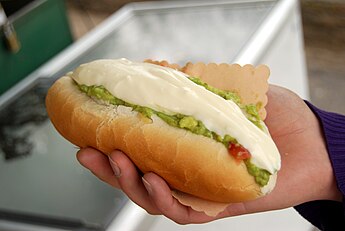Hot dogs may reign as the quintessential American food, but Chile has its own cult favorite: the completo. This sandwich has been a cornerstone of Chilean cuisine for nearly a century, even earning its own holiday on May 24th. While its origins may have stemmed from the U.S., the South American adaptation has taken on a life of its own. The dish was first made in the 1920s in the fuentes de soda (soda fountains) of central Santiago. The completo was brought to Chile by Eduardo Bahamondes who had recently travelled to the United States on business. It was there that he first saw the “hot dog” which he decided to bring back to his home country. Once back in Chile, he then opened a restaurant in Santiago’s historic centre called Quick Lunch Bahamondes in the Portal Fernandez Concha where he began to introduce the Chilean people to the hot dog. As people didn’t like the original preparation, he added other ingredients such as tomato and avocado, which eventually became accepted by the public.
In Chile, you’ll find bustling street vendors dishing out these hearty delights, while sandwich shops and casual eateries also serve up their unique renditions.
What sets the completo apart is its array of toppings, which truly make it “complete” as its name suggests. From juicy tomato slices and creamy avocado to tangy sauerkraut, crisp onion, and fragrant parsley, each ingredient adds its own dimension of flavor and texture. Among the many variations, the Italiano stands out, featuring tomato, mayonnaise, and avocado, paying homage to the colors of the Italian flag.
But the creativity doesn’t end there. With toppings ranging from green beans and crispy fries to fluffy scrambled eggs and gooey melted cheese, the completo offers endless possibilities for a quick and satisfying meal.
A completo stands as a cherished Chilean take on the classic “loaded” hot dog. Frequently found at street vendors and casual eateries, this dish features a traditional hot dog nestled in a bun and crowned with sauerkraut, diced tomatoes, mashed avocado, and a lavish drizzle of mayonnaise. Utilize your preferred hot dog brand and cooking method, along with robust buns, to whip up this simple yet festive completo. These hearty creations serve as a substantial main course, best enjoyed with an ample supply of napkins.
Throughout Chile, specific names are used to describe the different variations of completos:
Completo: Sometimes referred as completo-completo in order to differentiate it from the other variants, it’s the most traditional version. Its ingredients include chopped tomatoes, mayonnaise (a large amount), sauerkraut and salsa americana.
Completo Italiano or simply Italiano: topped with chopped tomatoes, mashed avocados and mayonnaise, this variation is widely viewed as the most popular. The name comes from its resemblance with the colors of the Italian flag.
Dinámico (“Dynamic”): A mix of the aforementioned ingredients (tomatoes, avocados, mayonnaise and sauerkraut) or salsa Americana.
Completo A lo Pobre (“Poor man’s completo”): Made with fried onion, french fries and a fried egg on top of the hot dog. The “poor man’s” in the name is due to the fact that the main ingredients are the same of bistec a lo pobre a main dish historically favoured by low wage workers.
Tomate mayo (“Tomato-mayo”): As its name suggests, it is a version with only chopped tomatoes and mayonnaise.
Ingredients
4 hot dogs (best brands with no sugar and real beef include Applegate, Wellshire Farms, and Pederson’s Family Farms—however, Nathan’s or National Hebrew are not as bad as the rest of the supermarket brands, if you can’t find these specialty brands with no sugar added and less preservatives and less junk)
1 large ripe avocado, halved and pitted
2 teaspoons hot sauce (such as Cholula)
1 teaspoon minced garlic (about 1 clove), mashed into a paste
½ teaspoon fresh lime juice (from 1 lime)
¼ teaspoon kosher salt
4 hot dog buns
½ cup prepared sauerkraut
¼ cup mayonnaise
1 lime, cut into wedges
Directions
Step 1
Cook hot dogs according to package directions. Open fire with wood is most traditional. I heated my gas grill for a two-level fire, with one side cranked up to high and the other side more toward medium-low. I started the hot dogs on the cooler side, cooking about 1 1/2 minutes per side to heat them through. Then I moved them to the hot side of the grill, turning them frequently until they developed an even brown color and a few spots of char. I did not close the grill lid as I cooked. This method simply blows all the other methods of boiling, broiling or stovetop away, giving the hot dogs both superior texture and exemplary flavor. Biting in, there was a noticeable snap of the casing, followed by intense juiciness in the tender middle. The teensy bit of char contributed irresistible robust woodsy flavor, complementing and contrasting the salty-cured, sausage-y nature of the franks. A grilled frank is, basically, the platonic ideal of a hot dog. The key to the success of the grilling method is two-zone heat — a cooler side to warm the hot dogs through gently, and a hot side to finish them off with a little sear and char. With a gas grill, it’s easy to create these zones, but you could also bank charcoal more densely on one side and have the coals more sparse on the other. The flavor and texture payoffs make grilling absolutely worth the little bit of effort, but if you don’t have a grill, the broiler method works pretty well in a pinch. It just won’t give you that smoky char finish.
Step 2
Mash avocado until mostly smooth. Stir in hot sauce, garlic, lime juice, and salt. Place hot dogs in buns and top each with 3 tablespoons of avocado mixture, 2 tablespoons sauerkraut, and 1 tablespoon mayonnaise. Serve immediately with lime wedges.

